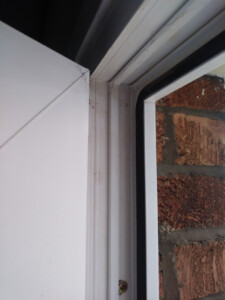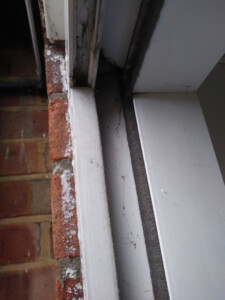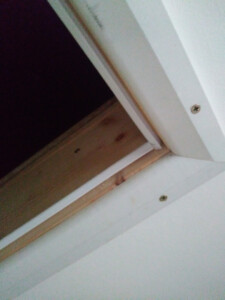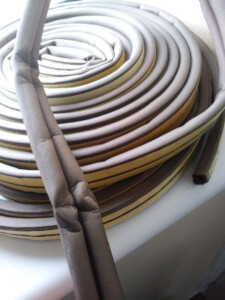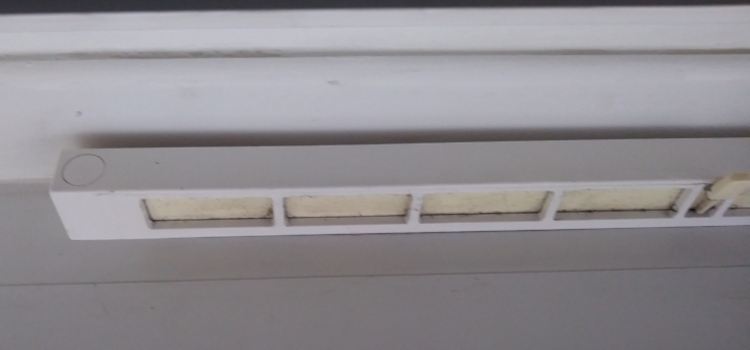Improve draught proofing
Priority for Completion: Very High
This recommendation is made when a home's door and/or windows don't meet current standards for draught proofing. This means you are likely to have uncomfortable cold draughts wasting heat from your home.
Improving the air tightness of a property can significantly reduce heat loss and improve energy efficiency. It is easy to do, even for people with limited DIY skills. Installation generally does not take long and the materials are relatively cheap. As a result, it usually pays back quickly.
In some circumstances, increasing the air tightness of a property too much can result in issues with damp and condensation. However, it is unlikely that simple measures will cause this problem in most cases. Additionally, simple measures can be taken to ensure controlled ventilation occurs to prevent these complications.
In balance, we have rated this improvement as one of very high priority for completion as it will both improve the energy efficiency and comfort of your home at low cost.
What do you mean by draught proofing?
In simple terms, draught proofing is any measure to stop air moving in or out of the building in an uncontrolled way. In a domestic EPC it mainly refers to the potential gaps between doors and windows and their frames. However, gaps can occur at any construction junction. Other particular issues can be loft hatches, ceiling and wall joins or poorly fitting door and window frames.
You may have noticed the brushes or spongey strips on modern doors and windows that make sure they seal properly to stop draughts. Effective draught proofing does not need to be any more complicated than this. Self adhesive strips are available from many hardware and DIY stores which work very well. Additionally many other products including nail on seals for wooden frames are available.
When you are adding draught proofing, don't forget any loft hatches you have. Cool air naturally drops down to lower levels as warm air rises. Poorly fitting loft hatches can allow heat from your home to easily escape through your roof.
What about ventilation?
Making sure your property has adequate ventilation is very important. Good ventilation prevents some problems with damp, mould and condensation. It can also help keep your family healthy and prevent disease transmission.
Most homes rely on natural ventilation to provide regular air change although rarely mechanical ventilation is used.
Condensation and mould can normally be controlled by reducing activities that release water vapour into the home like drying clothes on radiators (something which is also a fire hazard). Proper extraction from kitchens, bathrooms, toilets and showers also has a large impact. Additionally, you should always make the most of good weather and open windows to help ventilate your home.
Further information about good ventilation in dwellings can be found in Building Regulations (Part F for England). Approved Document F and the Domestic Ventilation Compliance Guide have more extensive guidance.
Other considerations
Whilst you are considering the energy efficiency of your loft hatch, consider making sure it is suitably insulated to prevent heat loss into your loft space. Again, it is generally easy to fit insulation to the back of the hatch and it can prevent heat being lost into your loft.
If you want to ensure you really stop draughts around your home you can consider sealing any gaps between walls and window or door frames. Also check around any pipes or cables coming in or out of your home for gaps and fill these. This is best done on both the inside and outside. It will also help prevent pests and vermin gaining access to your home. A variety of sealants and expanding foam fillers are available that are suitable for these purposes. Similarly you can use suitable calking to fill any gaps between walls, ceilings, floors and skirting boards in your home.
Improve draught proofing
Priority for Completion: Very High
This recommendation is made when a home's door and/or windows don't meet current standards for draught proofing. This means you are likely to have uncomfortable cold draughts wasting heat from your home.
Improving the air tightness of a property can significantly reduce heat loss and improve energy efficiency. It is easy to do, even for people with limited DIY skills. Installation generally does not take long and the materials are relatively cheap. As a result, it usually pays back quickly.
In some circumstances, increasing the air tightness of a property too much can result in issues with damp and condensation. However, it is unlikely that simple measures will cause this problem in most cases. Additionally, simple measures can be taken to ensure controlled ventilation occurs to prevent these complications.
In balance, we have rated this improvement as one of very high priority for completion as it will both improve the energy efficiency and comfort of your home at low cost.
What do you mean by draught proofing?
In simple terms, draught proofing is any measure to stop air moving in or out of the building in an uncontrolled way. In a domestic EPC it mainly refers to the potential gaps between doors and windows and their frames. However, gaps can occur at any construction junction. Other particular issues can be loft hatches, ceiling and wall joins or poorly fitting door and window frames.
You may have noticed the brushes or spongey strips on modern doors and windows that make sure they seal properly to stop draughts. Effective draught proofing does not need to be any more complicated than this. Self adhesive strips are available from many hardware and DIY stores which work very well. Additionally many other products including nail on seals for wooden frames are available.
When you are adding draught proofing, don't forget any loft hatches you have. Cool air naturally drops down to lower levels as warm air rises. Poorly fitting loft hatches can allow heat from your home to easily escape through your roof.
What about ventilation?
Making sure your property has adequate ventilation is very important. Good ventilation prevents some problems with damp, mould and condensation. It can also help keep your family healthy and prevent disease transmission.
Most homes rely on natural ventilation to provide regular air change although rarely mechanical ventilation is used.
Condensation and mould can normally be controlled by reducing activities that release water vapour into the home like drying clothes on radiators (something which is also a fire hazard). Proper extraction from kitchens, bathrooms, toilets and showers also has a large impact. Additionally, you should always make the most of good weather and open windows to help ventilate your home.
Further information about good ventilation in dwellings can be found in Building Regulations (Part F for England). Approved Document F and the Domestic Ventilation Compliance Guide have more extensive guidance.
Other considerations
Whilst you are considering the energy efficiency of your loft hatch, consider making sure it is suitably insulated to prevent heat loss into your loft space. Again, it is generally easy to fit insulation to the back of the hatch and it can prevent heat being lost into your loft.
If you want to ensure you really stop draughts around your home you can consider sealing any gaps between walls and window or door frames. Also check around any pipes or cables coming in or out of your home for gaps and fill these. This is best done on both the inside and outside. It will also help prevent pests and vermin gaining access to your home. A variety of sealants and expanding foam fillers are available that are suitable for these purposes. Similarly you can use suitable calking to fill any gaps between walls, ceilings, floors and skirting boards in your home.

